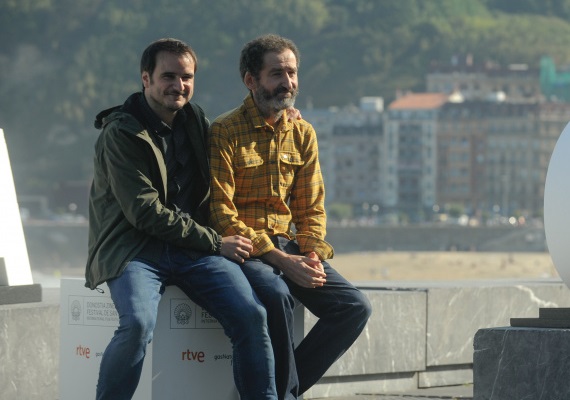Aitor Arregi and Jon Garaño • Directors
“The biggest challenge was having a giant for a main character”
- SAN SEBASTIÁN 2017: Basque filmmaking duo Aitor Arregi and Jon Garaño present Giant, a period drama that recounts the true story of the so-called "Giant of Altzo", who lived in the 19th century

Giant [+see also:
film review
trailer
interview: Aitor Arregi and Jon Garaño
film profile] is a historical reconstruction of a real case of a man who began to grow uncontrollably. Written, directed and produced by Aitor Arregi and Jon Garaño (with the help of partners at Moriarti Produkzioak), the film was unveiled at the 65th San Sebastián International Film Festival amid high levels of expectation, both as a Basque-language film and a successor to the highly successful Flowers [+see also:
film review
trailer
film profile].
Cineuropa: There’s a real buzz of expectation at the festival following the positive impression left by Flowers three years ago.
Aitor Arregi: Yes, we’re not new faces around here anymore (I was a screenwriter back then) and we’ve given a great deal of thought to what we can offer the audience, looking for alternative paths, which is something that the characters in our film also experience — they have to manage people’s expectations, offering first one thing and then another in order to win the applause of their audience.
Jon Garaño: We were also interested in the ways that myths, stories and real events are constructed, disseminated and distorted: when does a man stop being a man and become a myth? There’s a sequence in Giant that raises this question: we see them reading a newspaper, an exact replica of a newspaper of the time, in which reality is being warped to sell an exaggerated version of the truth. But that’s the ultimate aim of cinema too — we are also contributing to the circulation of a distorted account of a real historical figure.
You also address the idea of selling oneself out, something that was perhaps beginning to be an issue at that time.
It was a period when the tension between the old world and the new was very apparent. When we did our background research, we saw that this kind of conflict was very much a part of life in Spain and across Europe at that time, with the Carlist Wars. Against this backdrop, the main character falls ill and begins to grow. One of the themes we wanted to explore was that of change, and how we confront the changes to come, how we react. There’s also a slight tinge of the western about this era, because in western films you see the conflict between the new civilisation on the horizon and those who have always done things in a particular way. We wanted to capture the birth of this struggle to adapt and be true to oneself, and tie that in to the brothers and the commercial enterprise they embark upon.
How to evolve, while remaining true to yourself, is a big question.
The protagonist is someone who was once just a normal person, but who since the age of twenty has never stopped changing, although he would prefer not to. This is what happens with society: no matter how hard we try to keep things the same, change is inevitable.
In terms of production, was it a very expensive film to make, because of the period setting and the special effects?
We had a miraculously large budget for a Basque-language film, three and a half million euros, but at the same time that’s small for the story we wanted to tell, so we had to think carefully about where we could have the greatest impact. In the end, that restraint came across very well in the story of the brothers. The special effects were designed not to be noticed: you have to forget that the main character is a giant. At first, his rapid growth is disconcerting, but we didn’t want audiences to be watching the film and wondering all the while how we did it. We wanted him to be a believable “big man”, and David Heras, the special effects supervisor at USER T38, told us that our greatest challenge was having a giant for a central character. In other films, giants appear for just a few minutes; they’re not constantly on-screen. In the end, we used a combination of mechanical effects during filming and visual effects created in post-production. We are so grateful both to the crew, who worked so hard, and to the producers. In comparison with our previous films, Giant is a blockbuster; we had to keep the big picture in mind without losing sight of the characters themselves.
(Translated from Spanish)
Did you enjoy reading this article? Please subscribe to our newsletter to receive more stories like this directly in your inbox.















